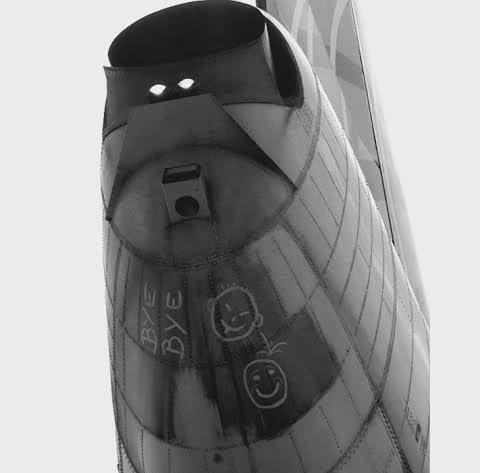
Earlier this week 13 flight attendants filed a whistleblower complaint with the Department of Labor’s Occupational Safety and Health Administration (OSHA) against United Airlines. The 26-page document claims that United fired them illegally in retaliation for refusing to fly on a 747 from San Francisco to Hong Kong last summer because of suspicious images and a message scrawled on the tail of the airplane. According to the Chicago Tribune, the flight attendants had a total of almost 300 combined years of experience—not that it mattered to the airline.
According to the complaint, the combination of “BYE BYE” and one face that looked “devilish” worried the crew enough to request that United complete a thorough inspection of the 747 to make sure no explosives were planted within the aircraft. The airline refused, the flight attendants refused to board the plane . . . and then all of them were fired for insubordination.
Are we talking about cautious professionals during an uncertain time, or was this a total overreach?
According to the attorney representing the flight attendants, his clients “did exactly what the flying public would expect from a group of highly experienced airline professionals.” David J. Marshall claims the mass firing violated the Wendell H. Ford Aviation Investment and Reform Act for the 21st Century (AIR21), legislation signed into law in 2000 to protect whisleblowers from retaliation if they report any problems with airline security. According to Bloomberg, United followed the company’s, and the Federal Aviation Administration (FAA)’s guidelines, found nothing alarming, and even described the incident as a “joke.”
So was this a just a prank? Let’s take a step back and look at airport security in general. Plenty of experts will tell you air travel security in the U.S. is a joke. Pat-downs, checking every piece of luggage, high-tech scanners—they all give the appearance of security, but they do not confront the stubborn fact that all these procedures combined are more “security theater” than a guarantee of our safety. At the same time, one would think the airlines learned the error of their ways after the 9/11 attacks—their penny pinching ways (poorly paid security staff, and few of them at that before 2001) were among the reasons a bunch of guys were able to use four airplanes as WMD’s. No company wants to go endure a disaster that would cripple a company’s reputation just when the airlines are finally performing well financially, so chances are the silly faces scrawled on that 747’s tail merited little more than a quick screening and not a fully loaded investigation.
Nevertheless, dismissing the concerns of a group of flight attendants, all of whom had at least 18 years of experience, is a bit much. Firing them goes too far--a suspension would have been more reasonable. At first glance it seems easy to mock the flight attendants for being overly cautious, but this also appears to be a one-off incident. Many of us bemoan the skies for no longer being friendly, but in fairness to pilots and flight attendants, flying is far from glamourous and the benefits are not what they were a generation ago. This July incident should serve as a case study, not another chapter in the long running tensions between airlines’ workers and management.
Based in California, Leon Kaye has also been featured in The Guardian, Clean Technica, Sustainable Brands, Earth911, Inhabitat, Architect Magazine and Wired.com. He shares his thoughts on his own site, GreenGoPost.com.
Image credit: Katz, Marshall & Banks

Leon Kaye has written for 3p since 2010 and become executive editor in 2018. His previous work includes writing for the Guardian as well as other online and print publications. In addition, he's worked in sales executive roles within technology and financial research companies, as well as for a public relations firm, for which he consulted with one of the globe’s leading sustainability initiatives. Currently living in Central California, he’s traveled to 70-plus countries and has lived and worked in South Korea, the United Arab Emirates and Uruguay.
Leon’s an alum of Fresno State, the University of Maryland, Baltimore County and the University of Southern California's Marshall Business School. He enjoys traveling abroad as well as exploring California’s Central Coast and the Sierra Nevadas.














